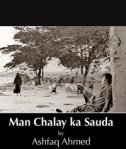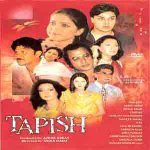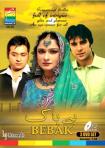Cable channels are no longer insulting the intellect of viewers as they forge their identity with quality dramas
2003-2007 are arguably the worst years of television history when the culture of soap operas that were mostly rip-offs of Star Plus soaps, besieged the satellite channels. With wafer-thin plots and high glamour quotient, these dramas were insulting to the average viewer who was used to high quality plays authored by Hasina Moin, Ashfaq Ahmed, Bano Qudsia, Noorul Huda Shah, Amjad Islam Amjad and their likes. The classic plays such as Man Chalay Ka Sauda, Parchaiyan, Nangay Paon, Waris, Khuda Ki Basti, Tapish and Hawaain had powerful screenplays, memorable dialogues with outstanding performances.
However storylines during the anni horribiles revolved around the shenanigans of either the business class and feudal lords or the conflict between the in-laws and the daughters-in-law. Besides soap operas, other forms of dramas such as the 15-22 episode serials also took on the flavour and structure of Indian soaps that were devoid of meaningful content. Rishad Mehmood, a former staffer at the Herald magazine (part of the Dawn Media Group) and covered culture extensively for the publication, in one of his pieces was extremely critical of the dramas that were being shown then. He had spoken to students who were disgusted with the ridiculous material that was being aired in the name of dramas.
Apart from that brief interlude, the last couple of years have seen a revitalisation of telly plays which even though are not outstanding in terms of content nevertheless, are drawing impressive viewership. Moreover, no longer can one hear people lamenting over the content of the plays in fact the viewer is now spoilt for choice. “For me it is a tussle between Hum TV and Geo TV when I am watching dramas, as both are producing some of the best plays at the moment,” says Gulrez Soomro, a mother of four kids and self-professed TV addict. Facebook pages are now created of every play where fans discuss the merits and demerits of every episode, as is done on several web forums where fresh episodes are promptly uploaded with the option of those who want to catch up on the play that they have missed or want to watch without ads also have very high viewership that runs in thousands. Desidramas.com and vidpk.com are two most popular web forums where viewers tune in to catch up on missed episodes. Hence Bol Meri Macchli, one of the most successful dramas of 2010 had average views of 6,000 on desidramas and 3,000 on vidpk per episode.
There are a couple of reasons behind this revival: new writers who are penning bold scripts, new directors with contemporary sensibilities and superior production values. Novel subjects are being explored which was never the case earlier even during the glorious days of the state-run television channel. Khuda Zameen Say Gaya Nahi (2009, Hum TV) and Bebak (2010, Hum TV) revolved around terrorism and its consequences. Partition Stories (PTV, 2008) a series of 12 plays, highlighted the loss and tragedy of every community during Partition and the humane values displayed by all of them at the time. Bol Meri Machli (Geo, 2010) grappled with exploitation of young vulnerable women in the showbiz world. Band Khirkiyoun Kay Peechay (TVOne, 2010) explored the goings-on of rich married socialites. “Zip, Bus Chup Raho on Geo was a very bold soap that was about a single parent who becomes a high-society escort to sustain the lifestyle of her kids,” says Soomro.
The writer-director duos of Umera Ahmed-Mehreen Jabbar/Babar Javed, Fasih Bari Khan-Mazhar Moin have played a critical part in drawing the viewers back to the small screen. Ahmed and Khan write scripts that revolve around regular issues faced by middle and lower-middle class people resonating with many of them. Deglamourised performances, powerful dialogues or even crude ones but very much rooted in Karachi’s authentic lingo especially in the case of Khan’s scripts, multiple problems faced by characters are the highlights of these two writers’ screenplays. Whether it is Mann-o-Salwa, Meri Zaat Zarra-e-Benishan, Malaal, Jhumka Jaan and Doraha, all penned by Ahmed and broadcasted in the last couple of years, have been highly popular because of their subject matter.
Malaal directed by Mehreen Jabbar, explored the relationship of an older woman and a younger man along with the marriage of two incompatible individuals who have a wide age gap. Weaved into the storyline was an internet-based relationship that is abruptly ended when the girl decides to get married to a handsome US well-settled man whom she barely knows. Mann-o-Salwa directed by Javed, chartered the rise of a woman from humble origins to a high-end escort who is spiritually and emotionally distraught. Most of these plays have been shown by Hum TV, which was launched by Sultana Siddiqui in 2005, a respected former director in PTV, a channel that has played a significant role in drawing back viewers with quality dramas. “Hum TV has played a major role in diverting people from routine dramas. I still remember fondly Lahasil and Mann-o-Salwa which the channel showed,” says Soomro.
Following the lead of Hum TV, other channels too have started to invest in strong plays. For instance last year Geo showed Meri Zaat Zarra-e-Benishan (MZZBN). This was scripted by Ahmed and became a massive success. With its central theme on taking false oath over the Holy Quran and its consequences, skilful acting especially by Samiya Mumtaz and Samina Peerzada, a heartfelt title song by Rahat Fatah Ali Khan, scored a five on the rating system where normally a scoring of two or three is considered a hit for a drama. This rating was unprecedented in the history of satellite television, according to Abdullah Kadwani, the head honcho of Seventh Sky Productions that produced MZZBN. The serial received a phenomenal 1, 68,000 emails and 6.3 million hits on various websites. “We were selling an average of 100 DVDs of MZZBN every month,” says Naseer Ahmed, salesman at Laraib music and film shop.
Another duo who must be credited for this resurgence is writer Fasih Bari Khan and director S. Mazhar Moin. Their focus on lower middle class themes shorn of artifice has been a successful formula. In fact it has done so well that their telefilm Burnes Ki Road Neelofar (ARY Digital), which was about a lower-middle class harassed housewife and a mother of nine kids, that it garnered a best supporting actress award for Hina Dilpazeer Khan, incidentally her debut, at the 7th Karafilm festival in 2009. Specialising in tele-films the duo has explored a range of ground-breaking topics. In Lunch with Lubna (Hum TV, 2010) an emotionally weak veteran actress breaks down under the insensitive questioning of a celebrity anchorperson and Karakti Bijlian (Geo, 2011) depicted the struggles of ageing stage performers.
Besides the scripts, improved production values with bigger budgets have contributed significantly to the scope of dramas. Crisp and clear images, superior sound quality along with authentic set design and costumes have also increased viewership. “The period play Dastaan was very well-made,” says Soomro. A high-budgeted drama, Dastaan was an adaptation of a well-known book authored by Razia Butt set during the Partition. “We invested heavily in the costumes and the sets of Dastaan that each episode costed us an average of 10 to 11 lakh rupees,” says Siddiqui, Chairperson of Eye Television Network. She also adds that the drama even attracted several advertisers, so much so that she had to decline quite a few since too many commercials irritates viewers.
The question that arises is will the good times last? Mehmood thinks that they will. “We have come back to topics related to our lives and have salvaged what we lost,” he says. Siddiqui however is not optimistic unless the television industry adopts some long-term measures. “We will have to invest in improving technical skills of our human resources. My fear is that there will be deterioration of quality if we don’t set up television academies where people are trained in all aspects such as cinematography, set design, acting, script-writing and direction. And we as in the media houses need to do this,” says Siddiqui.



